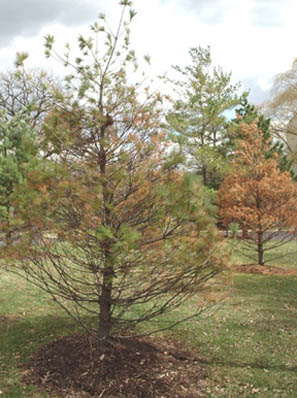White Pine Stress | |
|---|---|
| May 21, 2008 | |
|
Most of the plant problems we have seen lately at the Plant Clinic involve noninfectious causes. Although the cool, wet conditions this spring have slowed growth temporarily, the real problem occurred last year. Heat and water stress of last summer will be manifested in poor tree growth this year. Root injury that occurred last summer will show as top dieback, decline, and stunted growth in many species. White pines are often indicator trees of soil stress. They often show symptoms before other species. We are seeing that again this spring on white pines. “White pine decline” is a name used to identify a complex of stress factors resulting in poor growth and/or slow decline of white pines. Other pine species are not affected to the same extent. The image shows a live, affected white pine tree next to one that will not recover.  White pine problems seem to be present throughout the state, especially in central and southern areas where conditions do not favor this species. Symptoms vary but generally include some pattern of needle yellowing or browning, small needle size, stunted growth, sparse foliage, shriveled bark on branches or trunk, sap exudate on branches, and in some cases death of the tree. Affected trees have ranged in size from 2 feet to more than 20 feet, indicating that trees of any size could be affected. White pines thrive in the cool, moist, well?drained soils of Wisconsin forests as understory trees. Many of the problem trees we have seen in Illinois have been situated on clay sites or exposed to the elements (planted in new housing developments or used as windbreaks). It is likely that site stress has contributed to the decline of these trees. Both flooding and drought can add to the problem, causing additional root injury. Many times, we see one or two trees in a windbreak that are affected. Possibly crowding and competition are factors in those cases. Sometimes, trees recover. Of the many white pines examined over the years at the Plant Clinic, the common factor seems to be root decline. Few live, fibrous, white roots have been found on white pines in decline; and in most cases fungal pathogens have not been found. Roots may be in decline for many reasons. Some factors contributing to white pine decline include clay or poorly drained soil, compaction, heat stress to roots, drought, flooding, deep planting, girdling roots, and sudden extremes in temperature and moisture. Pines prefer acidic soil, so the alkaline soils in Illinois landscapes (and alkaline irrigation water) may also be part of this complex. In a few cases, oozing sap near the soil line has been associated with Procerum root rot, a root decline caused by a weak pathogen known to invade stressed trees. Often trees with white pine decline do not recover. Because there is nothing infectious in these trees, waiting to see if the trees recovers will not jeopardize the health of nearby white pines. Entomologists point out that if bark beetles invade the declining tree, you should remove the tree to avoid a bark beetle problem on nearby pines. Watering helps (except in cases of flooding stress), as does the use of natural mulch (such as shredded bark) over the root system. Still, without adequate root mass, plants are not able to use the available water quickly enough to replace what is used by the foliage. The result is sudden browning or off?color needles and death of branches. | |
| Author: | Nancy Pataky |
